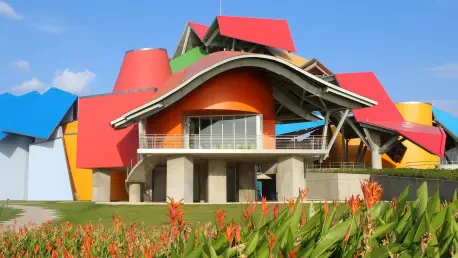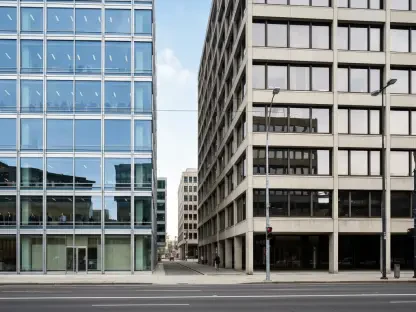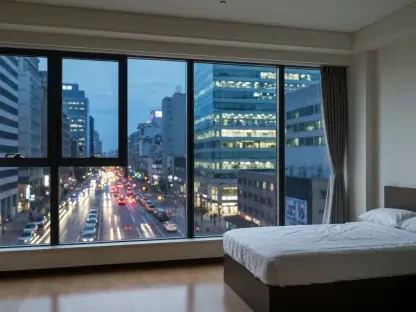In urban areas where space is often at a premium, finding ways to maximize every inch of an outdoor area becomes crucial. Gardens, no matter how small, offer fresh air and a sense of tranquility amidst crowded city landscapes. This pursuit reflects not only a need for beautifying one’s personal environment but also for crafting an oasis that relieves urban stress. Across the globe, people are increasingly turning to innovative garden design ideas that prioritize both aesthetics and functionality, transforming small patches of greenery into vibrant havens. By harnessing creative techniques like vertical gardens and strategic plant choices, even the most modest spaces can exude lushness and life.
Utilizing Vertical Spaces
The Art of Vertical Gardening
Unveiling the skies as an extension of garden space, vertical gardening serves as a linchpin in optimizing limited outdoor areas. This practice not only increases greenery but also introduces a dynamic dimension to traditional garden design, making vertical gardening an appealing solution to spatial constraints in urban settings. By utilizing walls, fences, and standalone structures, homeowners can elevate their green spaces without encroaching on precious ground space. The strategic use of climbing plants transforms dull facades into lush tapestries, offering a sense of depth and continuity. Additionally, hanging gardens offer a versatile approach to vertical spaces, allowing plants to cascade elegantly in designated zones.
The appeal of vertical gardens lies in their ability to accommodate a variety of plant species, from colorful flowering vines to edible herbs. These installations often require lightweight support structures and can be crafted using innovative solutions like repurposed pallets or metal frameworks for modular plant arrangements. Furthermore, vertical gardens encourage biodiversity through the combination of different plant types, which is essential for attracting pollinators and encouraging a robust mini-ecosystem. This diversity not only beautifies small urban environments but also makes them ecologically functional, hosting a myriad of beneficial organisms.
Creativity in Design and Implementation
Crafting a vertical garden is as much a creative endeavor as it is a practical one. Gardeners often incorporate a mixture of plants with varying foliage textures and colors, creating a visually stimulating arrangement reminiscent of a natural landscape. The infusion of succulents, ivy, ferns, and even small trees into vertical gardens adds layers of intrigue akin to a living tapestry. Such diversity ensures the space remains visually captivating throughout the seasons. Mirror edging, a more artistic approach, can also be included to reflect light and greenery, augmenting the perceived size of the garden.
Moreover, vertical gardens offer convenience in care and maintenance, often being more accessible than traditional layouts. By elevating plants, easier access for watering and pruning is enabled, requiring less bending or stretching. Automated irrigation systems can be integrated within vertical gardens to ensure consistent moisture levels, reducing the manual labor involved in upkeep. Providing proper drainage to prevent waterlogging is a precursor to successful cultivation, and with the aid of technology, gardeners can maintain optimal conditions with minimal hassle, fusing form and function in an artful display.
Strategic Plant Selection
Crafting an Aesthetic and Practical Balance
Strategic plant selection serves as a cornerstone of small garden design, ensuring the garden remains lush yet manageable, vibrant yet sustainable. Selecting plants based on their mature size and growth patterns prevents overcrowding, a common challenge in snug spaces. Hardy native species like Banksia and Grevillea are preferred for their resilience and ecological advantages, harmonizing with local climates and supporting indigenous wildlife. By establishing a balance between aesthetic appeal and practical upkeep, these carefully chosen plants thrive while adding beauty.
Color choices play a significant role in enhancing the appeal of small gardens, with vibrant hues serving as focal points that draw the eye. Incorporating a mix of fine-leafed plants and glossy foliage creates visual depth, casting shadows that dance across the garden as light changes throughout the day. The integration of blooming varieties like dwarf magnolias introduces a seasonal spectacle, adding an extra layer of charm and sophistication. This thoughtful selection strategy transforms even the smallest space into an enchanting retreat.
Fostering Biodiversity and Ecosystem Health
Integrating plant species for biodiversity supports not only aesthetic pleasure but also ecological balance, fostering a micro-ecosystem even in confined spaces. With careful planning, small gardens can become havens for pollinators and beneficial insects, enhancing both plant vitality and garden health. This ecological consideration encourages a harmonious interaction between plants and wildlife, promoting a thriving environment that supports life beyond mere horticulture. Pollinator-friendly species entice bees and butterflies, ensuring diverse plant appraisals while contributing to broader ecological health.
Resilience and sustainability are vital components within a small garden blueprint, ensuring longevity and reduced maintenance burdens. Sustainable practices, such as using low-maintenance and drought-tolerant plant varieties, prepare the garden for changing climatic conditions without sacrificing its lush appeal. Achieving a thriving garden requires understanding the unique environmental requirements of each plant species, meeting their light, soil, and moisture preferences accurately. This informed approach enables a garden that continues to flourish, captivating visitors while remaining environmentally respectful and deliberately nurtured.
Design Techniques for Exploiting Space
Multi-functional Features that Enhance Utility
Incorporating multi-functional elements within a garden stands as a hallmark of innovative design, offering utility while maintaining visual sophistication. Built-in seating, for example, not only embellishes the garden with architectural intrigue but also saves space, transforming boundaries into elegant relaxation spots. These features create a symbiotic relationship between plant arrangements and human interaction, encouraging outdoor enjoyment without compromising on sophistication. Textured finishes and natural materials integrate these elements seamlessly with their surroundings, making them part of the garden’s organic allure.
Garden furniture and components can serve as more than mere accessories, often doubling as planters or storage solutions. Designs that integrate seating with planter boxes blur the lines between functionality and aesthetics, optimizing every available nook. Lighting elements, crucial for extending usability into the evening, can also augment the ambiance, highlighting design features and facilitating a sense of warmth and inviting allure. Intelligent design choices ensure these elements contribute actively to the garden’s look and harmony, with minimal footprint and maximal impact.
Enhancing Perceived Space with Clever Techniques
Visually expanding a small garden relies on ingenuity and a clever understanding of perceived space, with mirrors serving as formidable allies in this task. Strategically placed, they reflect greenery and light, creating an illusion of expanded dimensions. Mirrors not only amplify a garden’s aesthetic boundaries but also reflect the natural beauty within, making them essential pieces of design resilience. Other optical illusions, like curved pathways or strategically staggered plant heights, can further elevate the perceived expansiveness, demonstrating a holistic understanding of spatial dynamics.
Layering plant heights and textures is another technique that provides depth and structure, tricking the eye into perceiving a larger area. By carefully choosing plant varieties that grow to varying heights, designers can craft a terraced effect that naturally draws the eye upwards and through the space, enhancing a sense of movement and freedom. This method maximizes light penetration and air circulation, essential for plant health, without compromising on aesthetic allure. The strategic use of boundary lines, whether soft hedges or hard landscaping elements, also defines and enhances the space without constricting its flow.
Privacy and Relaxation in Urban Gardens
Creating Intimate Retreats
Privacy in small urban gardens is paramount to creating an oasis for relaxation, where individuals can seek solace from the bustling city life. Using plants as natural screens effectively establishes a private, intimate atmosphere without the need for intrusive structures. Dwarf magnolias and bamboo, known for their dense foliage, are particularly well-suited to screening purposes, offering both seclusion and splendor. These natural barriers not only provide visual privacy but also help dampen external noise, creating an immersive experience in the heart of nature.
Incorporating subtle water features, like small fountains or birdbaths, further enhances relaxation by offering gentle acoustic backdrops that soothe the senses. Water elements, reflecting light and complementing plant life, heighten the tranquil atmosphere, promoting a sense of peace and rejuvenation. These features signify the indispensable role that nature plays in urban environments, acting as guardians of mental well-being and stress relief. Combining these elements with lush planting encourages a multi-sensory experience, drawing individuals into a tranquil world far removed from the surrounding noise.
Designing Gardens for Personal Harmony
In urban environments where space is often limited, making the most of every bit of outdoor space is essential. Gardens, regardless of size, provide not just a breath of fresh air but also a pocket of tranquility amidst the hustle and bustle of city life. This endeavor highlights the desire not only to beautify one’s personal surroundings but also to create a soothing retreat that mitigates the stresses of urban living. Globally, people are increasingly adopting innovative garden designs that emphasize both beauty and practicality. These designs transform even the smallest plots of greenery into lively sanctuaries. By employing creative strategies such as vertical gardening and selecting plants with care, even the tiniest spaces can become vibrant and full of life.
In many cities, residents may only have a balcony or a small patio as their outdoor area. Yet, with a bit of imagination and planning, these spaces can be turned into mini-gardens that offer relaxation and joy. Through the use of planter boxes, tiered arrangements, and climbing plants, city dwellers can maximize their urban gardens’ potential. By choosing plants that thrive in confined spaces and combining various textures, colors, and heights, these areas can become visually appealing and invigorating. Ultimately, urban gardening is about crafting a personal oasis that brings nature closer, offering residents a slice of serenity in their otherwise busy urban landscapes.









